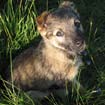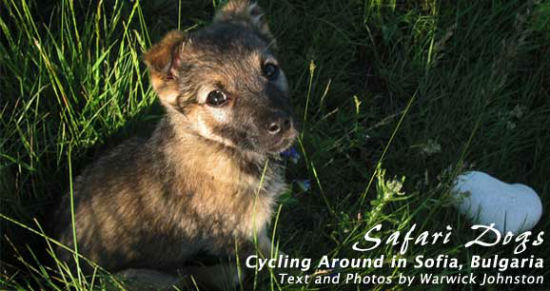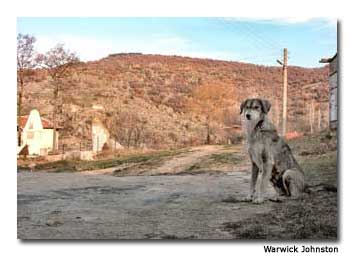

A low growl is the only giveaway that I’m under surprise guerrilla attack from behind. Looking behind to gauge the distance of my pursuer, I’m suddenly aware that he’s not alone, and there is a pack of his companions flanking me. The beast in front of me bares its teeth and snarls. It is only meters away and looks hungry. My pulse quickens. My throat constricts. Fight or flight?
Realizing I’m hopelessly outnumbered, I choose the latter. My nerves are shot by this close encounter with ferocious wildlife. Continuing, I’m tense in preparation for my next potentially deadly brush with aggressive and territorial wild dogs. Every sense alert, perspiration dripping from my brow, I’m on edge with the knowledge that a split-second decision holds my fate in its hand. I’m questioning my sanity in deciding to bicycle through deserted, potholed streets in this part of the world, particularly after dark.
No, I’m not in Africa. Far from it. I’m actually in Sofia, Bulgaria’s capital, cycling home after work from the Centre to Kniajevo, a distance of some eight fun-filled kilometers (about five miles). It’s a twice-weekly event: faced with the post-11 p.m. suspension of public transport, I take my life into my hands and face the reality of Sofia’s problematic street dogs.
While the animals seem less harmful during daylight hours, the nighttime is their territory and they defend it aggressively. On one late-night taxi ride home, three dogs were fearlessly charging in tactical formation toward my high-speed taxi. The driver took little notice, not slowing or deviating, and darted through the gap left between their jaws. The dogs miraculously escaped this encounter unharmed; though some of their companions have not been so lucky, judging by the occasional roadkill on Sofia’s arterials.
Sofia counts among its many concerns a major street dog problem. The official street dog population stands at 35,000, but many estimate this number to be over three times that amount. There are four stray dogs for every human inhabitant.
Bulgaria’s low human fertility rate, countered by its street dog population growth, and the battle for Sofia’s territory seems to have shifted from mafia maneuverings to canine gangland warfare. Attention has turned to Sofia’s “top dog.” Ineffective proposed solutions and other inaction means that the public is paying for the mayor’s blood. In the meantime, Sofia’s suburbanites are tackling the problem in the best way they can — by running.

The next pack of dogs lying in wait has had its attention roused by the indignant barking of the pack from which I just escaped. Knowing my only option is to imitate my taxi driver, I try to create some space for myself. Standing high on my pedals and growling threateningly, I launch into a tirade of woofs, barks, snarls and bow wow wows, praying that the Bulgarian dogs understand my Australian accent. The dogs, obviously having heard rumors about the infamous Crocodile Hunter, pause momentarily and I glimpse a glimmer of fear in their eyes. I lift my foot high, demonstrating intention to kick. The dogs part with respect and retreat to their hideout, discussing among themselves tactics for their next ambush. I live to ride another night.
If You Go
Gangs of street dogs, rubbish-collection problems, poorly maintained roads and dirty streets are hardly the stuff of postcards. But underneath the grim reality of daily life in Bulgaria’s largest city (population 1.1 million) lies an enthusiastic spirit, an underground vibrancy generated by an industrious young generation keen to make the most of opportunities.
Sofia is located in the west-central part of this Eastern European country on a high plain enclosed by the Balkan Mountains. Tourists may feel under-whelmed by Sofia’s sights at first, but for a true explorer, Bulgaria’s secret charms lay just beneath the surface, awaiting discovery. The city’s center is dominated by neo-classical communist architecture with rather depressing socialist-era block housing. But venture into the side streets and you will find tree-lined boulevards, and century-old houses adorned with beautiful balconies built by Viennese architects.
There are public thermal springs in the capital city and many old churches such as 4th century St. George, or historic mosques like the Banya Bashi Mosque dating back to the 15th century. The university was established in 1889.
Rather than thrust itself in your face, Bulgaria beckons you to explore its heart, offering you the chance to feel like you are the first to do so. You can choose to immerse yourself in a mystical Thracian history — Sofia was founded about 3,000 years ago by an ancient Indo-European tribe — full of pagan festivals which are still honored to this day. Throw yourself into nature and unearth unspoiled eco-trails, or join a conservation project to re-establish a harmonious relationship between man and wolf.
These people can make your experience all the more rewarding:
Lubomir Radev is Bulgaria’s most enthusiastic amateur archaeologist whose cycling/hiking tours stimulate mind, body and soul.
Georgi Hristov’s expertise on Bulgaria’s spiritual heritage will provide you with deeper insights into well-known tourist areas, or take you far off the beaten track to experience Bulgaria’s true mystique. [email protected]
Bulgaria Tourism Office
Sofia Travel Guide
www.explore-sofia.com
